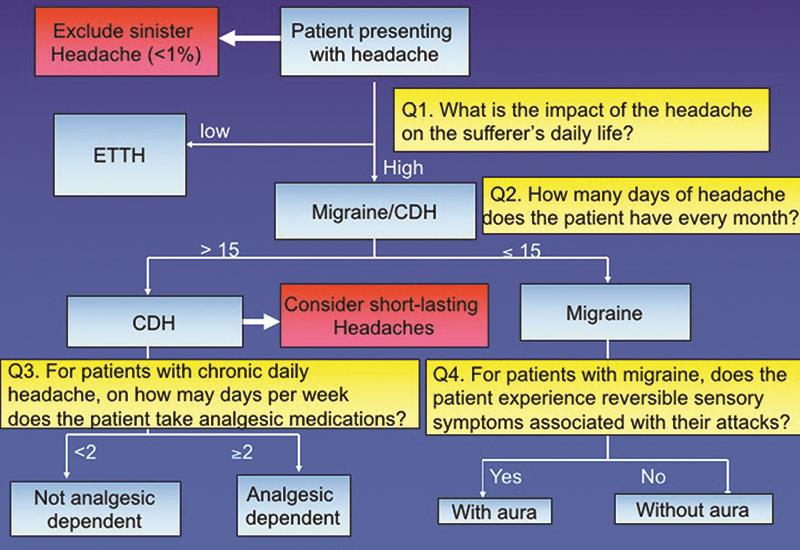Headaches are rapidly becoming the bane of modern life but attendees at Norville’s recent Medi-Lens Conference heard how research is offering new insights into the aetiology of headaches, new treatments and the role optometrists could play.
A fascinating talk by Dr Andrew Dowson, clinical lead at East Kent Headache Service, provided a medical view of headaches and provided a glimpse into a massively complex area. The good news is that it is commonplace for GPs to refer patients with headaches to an optometrist or for patients to seek help from an optometrist themselves.
From a medical point of view it is the sinister, serious headaches that Dr Dowson and his colleagues are interested in. These, he explained, tend to be sudden onset, often severe, events which do not adhere to regular, chronic headache patterns.
To underline the complexity of headaches Dr Dowson pointed out that the International Headache Society’s definition of headache ran to 188 pages. This has been condensed into a single page flow diagnosis diagram for GPs and is designed to highlight red flags. Thankfully less than 1% of people attending GPs surgery have sinister symptoms.
Dr Dowson provided a snapshot of the various types of headache: chronic daily headache, tension type, migraine and cluster headaches and gave examples of different treatments through a series of case histories before concentrating on migraine.
Use of the flow chart can place patients in the right category in a matter of seconds, he said. The cases also highlighted common issues such as patients, up to 10%, who have analgesic dependent headaches.
Treatment for different headaches includes the pharmaceutical: triptans, botox and the emergence of antibody drugs. Nutraceutical options include riboflavin and magnesium while preventative, often environmental, measures to reduce triggers are also an option. This is where optometrists have a role to help prevent headaches at source by eliminating visual stress that can bring on headaches and act as a catalyst for migraine. ‘Lenses can play a part in reducing these triggers,’ concluded Dr Dowson.
One in seven people will suffer migraine, Simon Evans, chief executive officer of Migraine Action, told delegates. ‘Migraine is not just a headache,’ he said before outlining the prevalence of the condition, the shortage of specialist help and the cost to the economy.
While four drug companies were racing to develop the next generation of antibody treatments, known as calcitonin gene-related peptide, or CGRPs, seven million people continued to suffer. He said help was at hand and urged his optometric audience to point suffering patients in the direction of Migraine Action. He also said products such as Vista Mesh can make a real difference.
Norville’s Vista Mesh lens is designed for a range of visually stressful uses such as night driving, computer use and harshly lit environments. It uses a mesh filter and anti-reflective coatings to reduce flicker, increase contrast and thereby reduce eyestrain.
MC for the day, Frank Norville, said from his involvement with self help meetings he had been surprised by the number of people attending and looking for anything that might help their condition. He suggested practices might like to hold migraine clinics to both help patients and add another string the practice’s bow. Products, such as the Vista Mesh lens had the potential to help migraine sufferers but were not widely known about. ‘Practices may like to hold a clinic from time to time to help patients who have no other place to go,’ he said.
Eye strain and migraine was brought together in the afternoon session by Professor David Thomson who gave an update on the ReadEZ System. His aptly timed presentation: ‘Visual Stress – Trick Or Treat’, to coincide with Halloween, described how the ReadEZ provides a computer based way of determining the optimum colour of tint for those who require them. The desired tint is established through the use of specialist software which can then be provided as a clip on or as prescription lenses in complete spectacles.
The Vista Mesh lens is used as the base lens and the desired colour is determined using a trial set of 24 tinted clip-ons in conjunction with the Thomson Software. Prof Thomson declared an interest and belief in colour overlays. He suffers from visual stress and supported arguments that visual stress, visual migraines and photosensitive epilepsy were all part of a common spectrum.

Professor David Thomson
He admitted to initial scepticism of colour overlays but concluded after 20 years of involvement in the field that colour does work in reducing visual stress and helping people read more comfortably. He cited the example of a successful, senior vet who came into his practice for reading spectacles.
He had suffered with reading issues his whole life but had masked the problem by closing off surrounding text. Prof Thomson fitted the vet with a blue lens which immediately solved his patient’s problem. ‘He was desperate to tell me it didn’t work,’ said Prof Thomson, but it did. ‘When you see something like that it’s not a placebo.’ Prof Thomson went on to successfully use a coloured overlay to alleviate his own visual stress, a symptom, he said, which often marked the start of a migraine.
In a quick romp through the ReadEZ system Prof Thomson concluded that ‘two colours was enough’, but that most of the colour overlay and lens tint systems available did pretty much the same thing. He also acknowledged the controversy surrounding the use of colour in the amelioration of dyslexia and explained the role a new eye tracker system could play in providing objective evidence that filters work.
He concluded: ‘Lack of evidence does not mean lack of effect.’ Randomised-controlled trials had their place but where expensive and not always practical.
‘There’s been an argument from the beginning that colour stabilises vision.’ He said the use of eye tracking in optometry could provide the evidence. ‘If and when that study is made it will show there’s a proven effect.’ In the meantime he said there was plenty of anecdotal evidence to say colour overlays work.

International Headache Society’s flow diagnosis diagram for GPs
Until recently eye tracking technology had been very expensive but a Scandinavian computer gaming company, Tobii, had developed a low cost bar which clips onto the bottom of a screen which could transform the use of eye tracking.
Norville jumped in to agree that the cost of randomised trials to create an evidence base was indeed expensive. Such a study would be in the order of £100,000 and simply could not be justified for low volume products. He said the peer review from professional use was sufficient. ‘I am quite happy that you, as professionals, are judge and jury in this area,’ he said.
Entering another controversial area Norville next introduced Greg Naes, president of BluTech Lenses. Naes said BluTech had been in the blue light blocking business since 2010, long before it became fashionable and had always put out measured arguments about what the lens can protect against and who should be wearing it. ‘All we do is blue light and harmful light, that is our thing,’ he said.
Naes suggested there were clear patient groups suitable for blue light blocking lenses and clear reasons for prescribing the lens. He went on to say that blue light lenses were now mainstream. In Italy and the US there are large optical chains dispensing around a third of their spectacles with blue light coatings.
He cautioned that conversation about blue light lenses needed to have two prerequisites. The discussion should be about indoors or outdoors use and the patient needs to know that the lens should not be clear. Indoors the peak emissions from devices centre around 455nm while outdoors the sun emits high levels of radiation between 400 and 500nm. The trick, he said, is to filter out the harmful blue light but to avoid colour distortion.
Indoor issues targeted by blue lenses are often connected to screens and include conditions such as eye strain, headaches and dry eye. These are even more important for young wearers who are also big technology users but have clear media, hold devices closer and have larger pupils.
He next made a definition between the different type of lenses and their performance in blocking blue light. While the very best blue coatings block up to 8% of the harmful blue light BluTech, which has the blocker in the monomer stops between 41% and 61%.
Referring to sanctions recently taken against firms making outlandish claims for blue lenses in the UK, Naes said: ‘We shouldn’t be making extensive medical claims.’ He suggested that the really powerful message was the role BluTech lenses could play in stopping the disruption on melatonin levels.
Melatonin depression and poor sleep are closely connected and in the US the cost of poor sleep is a big issue. Days lost to work due to poor sleep cost the economy dear while one study has shown children who spend too long on screen can see their academic performance drop by a full grade.
BluTech has three levels of protection which range from its clearest lens for indoors to a darker lens with greater levels of blocking for outdoor use.
In an interesting question and answer session Naes agreed that natural blue light had a role to play and only the necessary level of harmful light should be blocked. He contended that blue lenses would remain mainstream as mobile device manufacturer’s efforts to include blue light blocking in screen technology was not as effective as including the blocker in a spectacle lens.
Wrapping up the day Norville asked his customers to ‘watch this space’ for myopia control lens technology which he said still needed evaluation. He also said the long-awaited launch of electronically-controlled eyewear could be next year.
In a final shot said he wanted to know from the College of Optometrists and the AOP if they could be confident in their advice offered on blue light. Would that advice still hold true in 60 years time for the technology-loving youngsters of today. A letter is on its way to Optician.
